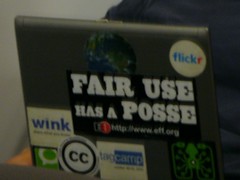The parties in the matter of Shell v. Devries, a case from the U.S. District Court for the District of Colorado, are no strangers to litigation with one another. In a previous civil rights lawsuit filed by plaintiff Shell, the defendants filed a motion for attorney’s fees, attaching thereto a copy of ten pages of Shell’s copyrighted website, profane-justice.org.
Shell filed a second lawsuit against the same defendants, this time claiming that the use of the pages as an exhibit to the filing in the previous case was an infringement of copyright. The defendants moved to dismiss under Fed. R. Civ. P. 12(b)(6), asserting a fair use defense. The court granted the motion.

Photo courtesy Steve Rhodes under a (CC) license.
The court disagreed with the defendants’ contention that use of copyrighted works in legal proceedings is “inherently” a fair use. Citing to the case of Images Audio Visual Productions v. Perini Bldg. Co., 91 F.Supp.2d 1075 (E.D.Mich.2000), it observed that where judicial proceedings are one of the intended markets of the copyrighted work, the copyright holder is entitled to exercise control over the use of his works within this market; the fair use doctrine does not require the wholesale abandonment of copyright protection at the courthouse door.
But at least two other cases have held that use of copyrighted works in court proceedings is protected by fair use. In Religious Technology Center v. Wollersheim, 971 F.2d 364, 367 (9th Cir. 1992) the court found fair use where the defendants copied and distributed religious scriptures from former members of the Scientology Church and gave them to expert witnesses for the purpose of preparing testimony in the case. In Jartech v. Clancy, 666 F.2d 403, 406-07 (9th Cir.1982), abbreviated copies of adult movies for use as evidence in a nuisance abatement proceeding were considered fair use.
In this case, the court examined the four factors of 17 U.S.C. 107 to conclude that the use made by the defendants in attaching the web pages to the motion was a non-infringing fair use.
First, there were no allegations in the complaint that the defendants used the material for the “intrinsic purpose for which it was prepared,” namely, to “generate income” or provide “creative analysis and commentary about events occurring related to the [previous] lawsuit.”
The second factor also weighed in favor of fair use, as the materials were primarily a chronology of events, and thus were more factual in nature than creative.
As for the third factor, the court observed that the use of the work was limited. Accordingly, the factor carried “very little weight.” In any event, citing to Sega Enterprises Ltd. v. Accolade, Inc., 977 F.2d 1510, 1526 (9th Cir. 1992), the court hled that “the fact that an entire work was copied does not . . . preclude a finding of fair use.” (The case of Kelly v. Arriba Soft Corp., 336 F.3d 811 (9th Cir. 2003) would also have been a good case to cite for this point.)
Finally, for the important fourth factor — the effect on the market of the copyrighted work — the court found that the complaint did not allege that the marketability of the work was impaired. Moreover, the court observed that “[i]ndeed, it is impossible to imagine how the defendants’ use of the materials as an exhibit to a motion for attorneys’ fees could in any way impact the marketability of the materials.”
Shell v. Devries, (Slip Op.) No. 06-318, 2007 WL 324592 (D.Colo. Jan. 31, 2007)
